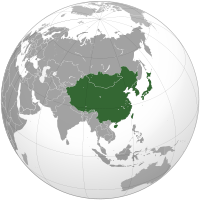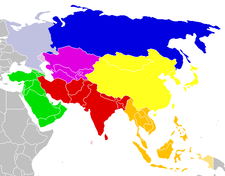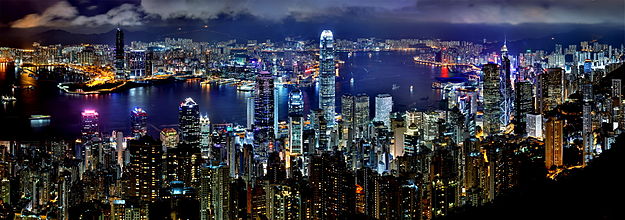- East Asia
-
For other uses, see East Asia (disambiguation).
East Asia 
Area 11,839,074 km2 (4,571,092 sq mi)[1] Population 1,575,784,500[2] Density 133 /km2 (340 /sq mi) Countries and territories  People's Republic of China
People's Republic of China
 Japan
Japan
 North Korea
North Korea
 South Korea
South Korea
 Mongolia
Mongolia
 Republic of China (Taiwan)
Republic of China (Taiwan)
 Hong Kong
Hong Kong
 Macau
MacauLanguages and language families Chinese, Japanese, Korean, Mongolian, and many others Nominal GDP (2010) $ 13.059 Trillion GDP per capita (2010) $ 8,308 Time zones UTC +7:00 (Western Mongolia) to UTC +9:00 (Japan and Korean Peninsula) Capital cities  Beijing
Beijing
 Tokyo
Tokyo
 Pyongyang
Pyongyang
 Seoul
Seoul
 Ulaanbaatar
Ulaanbaatar
 Taipei
TaipeiOther major cities  Busan
Busan
 Guangzhou
Guangzhou
 Hong Kong
Hong Kong
 Incheon
Incheon
 Kaohsiung
Kaohsiung
 Macau
Macau
 Osaka
Osaka
 Shanghai
Shanghai
 Yokohama
Yokohama
(see list)East Asia Chinese name Traditional Chinese 東亞 or 東亞細亞 Simplified Chinese 东亚 or 东亚细亚 Transcriptions Gan - Romanization Tung1 nga3 Hakka - Romanization dung24 a31 Mandarin - Hanyu Pinyin Dōngyà or Dōng Yàxìyà - Wade–Giles Tung1-ya3 Min - Hokkien POJ Tang-a Wu - Romanization ton平 ia去 Cantonese (Yue) - Jyutping dung1 aa3 Japanese name Kanji 東亜細亜(東アジア)/東亜 Kana ひがしアジア/とうあ Kyūjitai 東亞細亞/東亞 Transcriptions - Revised Hepburn Higashi Ajia/Tō-A - Kunrei-shiki Higasi Azia/Tou-A Korean name Hangul 동아시아/동아세아/동아 Hanja 東아시아/東亞細亞/東亞 Transcriptions - Revised
RomanizationDong Asia/Dong Asea/Dong A Mongolian name Mongolian Зүүн Ази
ᠵᠤᠨ ᠠᠵᠢ
Züün AziRussian name Russian Восточная Азия Romanization Vostochnaja Azija Vietnamese name Quốc ngữ Đông Á (Sino-Viet.)
Á Đông (native)East Asia or Eastern Asia (the latter form preferred by the United Nations) is a subregion of Asia that can be defined in either geographical[3] or cultural[4] terms. Geographically and geo-politically, it covers about 12,000,000 km2 (4,600,000 sq mi), or about 28 percent of the Asian continent, about 15 percent bigger than the area of Europe.
More than 1.5 billion people, about 38% of the population of Asia or 22% of all the people in the world, live in geographic East Asia, about twice Europe's population. The region is one of the world's most populated places, with a population density of 133 inhabitants per square kilometre (340 /sq mi), being about three times the world average of 45 /km2 (120 /sq mi), although Mongolia has the lowest population density of a sovereign state.[5] Using the UN subregion definitions, it ranks second in population only to Southern Asia.
Historically, many societies in East Asia have been part of the Chinese cultural sphere, and East Asian vocabulary and scripts are often derived from Classical Chinese and Chinese script. Sometimes Northeast Asia is used to denote Japan and Korea.[6] Major religions include Buddhism (mostly Mahayana), Confucianism or Neo-Confucianism, Taoism, Chinese folk religion in China, Shinto in Japan, Shamanism in Korea, Mongolia and other indigenous populations of northern East Asia[7][8], and recently Christianity[9] in South Korea. The Chinese Calendar is the root from which many other East Asian calendars are derived.
Contents
History
Main article: History of East AsiaUses of the term East Asia
The UN subregion of Eastern Asia and other common definitions[3] of East Asia contain the entirety of the People's Republic of China[10] (including all SARs and autonomous regions), Republic of China[11] (commonly known as "Taiwan"), Japan, North Korea, South Korea, and Mongolia[3]. China, Taiwan, Japan, Korea, and Vietnam are commonly seen as being encompassed by cultural East Asia:[12][13][14][15]
Alternate definitions
There are mixed debates around the world whether these countries or regions should be considered in east Asia or not.
- Vietnam (considered either East Asia or Southeast Asia—here the primary question is geographic due to it being part of the Sinosphere)
- Siberia in Russia[16] (considered either East Asia or North Asia—here the primary question is political, with culture and geography also at issue)
In business and economics, East Asia has been used to refer to a wide geographical area covering ten countries in ASEAN, People's Republic of China, Japan, South Korea, and Taiwan (officially the Republic of China) [11] for the purpose of economic and political regionalism and integration.[citation needed] United States foreign policy under the Obama administration considers Southeast Asia a part of East Asia.[17] The tendency of this usage, perhaps, started especially since the publication of World Bank on The East Asian Miracle in 1993 explaining the economic success of the Asian Tiger and emerging Southeast Asian economies (Indonesia, Malaysia, the Philippines and Thailand).[citation needed]
In addition, this usage has also been driven[says who?] by Asia-wide economic interconnectedness since the co-operation between ASEAN and its three dialogue partners was institutionalized under the ASEAN Plus Three Process (ASEAN+3 or APT) in 1997. The idea of East Asian Community arising from ASEAN+3 framework is also gradually shaping the term East Asia to cover more than China, Korea, Japan and Taiwan. This usage however, is unstable: the East Asian Summit, for instance, includes India and Australia.
East Asia is considered to be a part of the Far East, which describes the region's geographical position in relation to Europe rather than its location within Asia. However, in contrast to the United Nations definition, East Asia commonly is used to refer to the eastern part of Asia, as the term implies. Observers preferring a broader definition of 'East Asia' often use the term Northeast Asia to refer to the greater China area, the Korean Peninsula, and Japan, with Southeast Asia covering the ten ASEAN countries. This usage, which is increasingly widespread in economic and diplomatic discussion, is at odds with the historical meanings of both 'East Asia' and 'Northeast Asia'.[18][19][20] The Council on Foreign Relations defines Northeast Asia as Japan and Korea.[6]
Territory and region data
Demographics
See also: Ethnic groups of East AsiaPass of the ISS over Mongolia, looking out west towards the Pacific Ocean, China, and Japan. As the video progresses, you can see major cities along the coast and the Japanese islands on the Philippine Sea. The island of Guam can be seen further down the pass into the Philippine Sea, and the pass ends just to the east of New Zealand. A lightning storm can be seen as light pulses near the end of the video.
Country Area km² Population Population density
per km²HDI (2010) Capital  China (PRC)
China (PRC)9,596,961 1,339,724,852 138 0.663 Beijing  Hong Kong, China
Hong Kong, China1,104 7,061,200 6,390 0.862 Hong Kong  Japan
Japan377,930 127,950,000 337 0.884 Tokyo  Macau, China
Macau, China30 556,800 18,662 No Data Macau  Mongolia
Mongolia1,564,100 2,809,600 2 0.622 Ulaanbaatar  North Korea
North Korea120,538 24,346,000 198 No Data Pyongyang  South Korea
South Korea99,828 48,988,833 500 0.877 Seoul  Taiwan (ROC)
Taiwan (ROC)36,188 23,174,528 639 0.868 Taipei Economy
Main article: Economy of East AsiaCountry GDP nominal
millions of USD (2010)GDP nominal per capita
USD (2010)GDP PPP
millions of USD (2010)GDP PPP per capita
USD (2010) China (PRC)
China (PRC)5,878,257 4,382 10,085,708 7,519  Hong Kong, China
Hong Kong, China225,003 31,591 322,486 45,277  Japan
Japan5,458,872 42,820 4,309,432 33,805  Macau, China
Macau, China26,184 47,607 23,582 42,876  Mongolia
Mongolia5,807 2,111 10,256 3,727  North Korea
North Korea27,820 1,159 40,000 1,800  South Korea
South Korea1,007,084 20,591 1,457,063 29,791  Taiwan (ROC)
Taiwan (ROC)430,580 18,458 821,781 35,227 Cities
Main article: Cities of East Asia-
Tokyo is the largest city in the world, both in metropolitan population and economy.
-
Seoul is the capital and largest city of South Korea (ROK), and is a leading global technology hub.
-
Kaohsiung is the second largest city in Taiwan. Kaohsiung Harbor is one of the largest harbors in the world.
-
Shanghai is the largest city in China and one of the largest in the world, and is the leading commercial and financial centre of mainland China.
-
Taipei is the capital of the Republic of China (Taiwan) and is one of the world's leading technical centres in Asia.
-
Hong Kong, enclosed by the Pearl River Delta and South China Sea, is one of the world's leading global financial centres and is known for its cosmopolitan lifestyle.
See also

- East Asia Summit
- East Asian Community
- East Asian Games
- East Asian studies
- East Asian languages
- East Asian calligraphy
- Four Asian Tigers
- Sinosphere
- Yakutia
Notes and references
- ^ The area figure is based on the combined areas of the People's Republic of China (including Hong Kong, Macau, Aksai Chin, and Trans-Karakoram Tract), Japan, North Korea, South Korea, the Republic of China (Taiwan), and Vietnam as listed at List of countries and outlying territories by total area.
- ^ The population figure is the combined populations of the People's Republic of China (Mainland China, Hong Kong, Macau), Japan, North Korea, South Korea, and Republic of China (Taiwan) as listed at List of countries by population (last updated Feb 22, 2010).
- ^ a b c "East Asia". encarta. Microsoft. Archived from the original on 2009-10-31. http://www.webcitation.org/5kwbU9Hqq. Retrieved 2008-01-12. "East A·sia [ st áyə ] the countries, territories, and regions of China, Hong Kong, Japan, North Korea, South Korea, Macau, and Taiwan."
- ^ Columbia University - "East Asian cultural sphere" "The East Asian cultural sphere evolves when Japan, Korea, and what is today Vietnam all share adapted elements of Chinese civilization of this period (that of the Tang dynasty), in particular Buddhism, Confucian social and political values, and literary Chinese and its writing system."
- ^ See, List of countries by population density
- ^ a b "Northeast Asia." Council on Foreign Relations. Retrieved on August 10, 2009.
- ^ Chongho Kim, "Korean Shamanism", 2003 Ashgate Publishing
- ^ Andreas Anangguru Yewangoe, "Theologia crucis in Asia", 1987 Rodopi
- ^ "Background Note: South Korea". State. U.S. Department of State. http://www.state.gov/r/pa/ei/bgn/2800.htm. Retrieved 2000-04-27.
- ^ [1], Britannica Online Encyclopedia, saying: "The present political boundaries of China, which include Tibet, Inner Mongolia, Sinkiang, and the northeastern provinces formerly called Manchuria, embrace a far larger area of East Asia than will be discussed here...."
- ^ a b The Republic of China (ROC) has limited recognition internationally as a sovereign state, see Political status of Taiwan
- ^ Columbia University East Asian Cultural Sphere
- ^ R. Keith Schopper's East Asia: Identities and Change in the Modern World [2]
- ^ Joshua A. Fogel (UC Santa Barbara/University of Indiana) Nationalism, the Rise of the Vernacular, and the Conceptualization of Modernization in East Asian Comparative Perspective [3]
- ^ United Nations Environment Programme (mentions sinosphere countries) Approaches to Solution of Eutrophication [4]
- ^ "Encarta Encyclopedia". Archived from the original on 2009-10-31. http://www.webcitation.org/5kwbUdIqJ.
- ^ Nanto, Dick K. (2006-09-18). "East Asian Regional Architecture: New Economic and Security Arrangements and U.S. Policy". Congressional Research Service. p. 2. http://fpc.state.gov/documents/organization/75280.pdf.
- ^ Discussed in Christopher M. Dent (2008), East Asian regionalism. London: Routledge, pp.1-8
- ^ Charles Harvie, Fukunari Kimura, and Hyun-Hoon Lee (2005), New East Asian regionalism. Cheltenham and Northamton: Edward Elgar, pp.3-6.
- ^ Peter J. Katzenstein and Takashi Shiraishi (2006), Beyond Japan: the dynamics of East Asian regionalism. Ithaca: Cornell University Press, pp.1-33
External links
Regions of the world 
Africa Northern · Sub-Saharan (Central · Southern · Western · Eastern) 
Oceania Australasia (Australia) · Melanesia · Micronesia · Polynesia 
America North (Northern • Middle • Central • Caribbean) · South (Southern • Northern • Western) · Anglo · Latin 
Polar Arctic · Antarctic 
Asia Central · Eastern (Northeastern) · Northern · Southeastern · Southern (Indian subcontinent) · Western (Middle East) 
Oceans World · Arctic · Atlantic · Indian · Pacific · Southern 
Europe Central · Eastern · Northern · Southeastern · Southern · Western 
Seas List of seas Related Continents of the world · List of seas · Physical EarthCategories:
Wikimedia Foundation. 2010.






